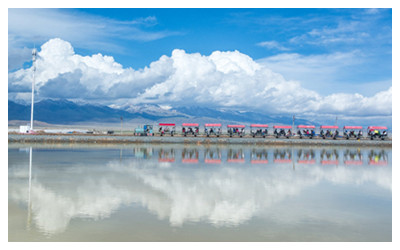Skype: neodalle-travel
Tel: +86 135 7447 2266
E-mail: sales@visitaroundchina.com
 Hainan Tibetan Autonomous Prefecture is seated in the southeast region of Qinghai Province in neighborhood of Haidong Prefecture, Xining City and Huangnan Tibetan Autonomous Prefecture in the east, Haixi Mongol and Tibetan Autonomous Prefecture in the west and Guoluo Tibetan Autonomous Prefecture in the south. In the north, it is separated from Haibei Tibetan Autonomous Prefecture by Qinghai Lake.
Hainan Tibetan Autonomous Prefecture is seated in the southeast region of Qinghai Province in neighborhood of Haidong Prefecture, Xining City and Huangnan Tibetan Autonomous Prefecture in the east, Haixi Mongol and Tibetan Autonomous Prefecture in the west and Guoluo Tibetan Autonomous Prefecture in the south. In the north, it is separated from Haibei Tibetan Autonomous Prefecture by Qinghai Lake.History of Hainan
Before the Western Han Dynasty (206BC-24AD) brought this area into the domain of the central government, Hainan Prefecture was inhabited by the Qiang and Rong nationalities which were all ancient tribes in western China. In 1953, Hainan Tibetan Autonomous Region was established and changed to the Hainan Tibetan Autonomous Prefecture two years later.
What to see in Hainan?
Lying in the Gonghe Basin, Qinghai Lake Basin and the Yellow River Valley, Hainan is lower in the center and higher in fringe area and the terrain slopes generally downward from the southwest to the northeast. Here lists top attractions in Hainan.
 |
 |
 |
| Longyangxia Eco-tourism Scenic Area | Daotang River | Guide National Geopark |
 |
 |
 |
| Laji Mountain | Chaka Salt Lake | Yuhuangge Pavilion |
When to visit Hainan?
The Hainan prefecture bears a continental plateau climate, featuring rarefied atmosphere, insufficient precipitation, long daylight hours and great temperature variation during a day and small temperate difference during a year. Hainan weather is dry and windy in spring, rainy and dank in autumn. Summer is short and cool, while winter is long and chilly. May to September is the beat time to visit this Prefecture.
How to reach Hainan?
Hainan Prefecture has better transportation among the regions in Qinghai Province. Qinghai-Tibet Highway (National Highway No.109) and Qingkang Highway (National Highway No.214) all run through the prefecture. The south line of the Qinghai-Tibet Highway passes through Nanhai, running westward through the mouth of Riyue Mountain along the south bank of the Qinghai Lake.
Daotanghe Town is a vital stop on these two highways. It is beside the Daotang (Backflowing) River of Riyue Mountain. Departing from the town, Qinghai-Tibet Highway stretches westward to contact with Haixi Mongol and Tibetan Autonomous Prefecture, while the Qingkang Highway runs to the southwest and gets to Guoluo and Yushu Tibetan autonomous counties.
Bus station in Gonghe County is located at 9, Lüzhou Nan Lu. Furthermore, each county has its own bus stations in the county seat.
Hainan Travel Tips
Special Local Products: Located in plateau area, unique climatic and physical features make some rare and precious Chinese medical herbs of perfect quality, such as snow lotus, Chinese caterpillar fungus, fritillary bulb and deer antler. Visitors should be cautious to identify if the Tibetan herbs on sale are real or false. Additionally, long-stalk pear and chang are all distinctive local products.
 Ask Questions ?
Ask Questions ?